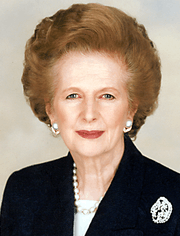Ralph Harris, Baron Harris of High Cross
| The Right Honourable The Lord Harris of High Cross | |
|---|---|
| Born |
Ralph Harris 10 December 1924 London, England |
| Died | 19 October 2006 (aged 81) |
| Nationality | British |
| Spouse(s) | Jose Pauline Jeffrey (m. 1949) |
| Institution | |
| Field | Economics |
| Alma mater | Queens' College, Cambridge |
| Influences | Friedrich Hayek |
| Part of the politics series on |
| Thatcherism |
|---|
 |
|
Ralph Harris, Baron Harris of High Cross (10 December 1924 – 19 October 2006[1][2]) was a British economist. He was head of the Institute of Economic Affairs from 1957 to 1988.
Background
Harris, the son of a tramways inspector, was "one of four children born to working-class parents on a council estate in Tottenham, north-east London".[3] He was educated at Tottenham Grammar School. He read Economics at Queens' College, Cambridge, graduating with a first-class degree.[3] At Cambridge he was influenced by Stanley Dennison, "who introduced him to the works of Friedrich von Hayek".[4]
Career
After working at the Conservative Political Centre at Conservative Central Office,[4] Harris was a lecturer in political economy at St Andrews University from 1949 to 1965.[3] He was an unsuccessful Conservative Party candidate for Kirkcaldy in 1951 and for Edinburgh Central in 1955,[3] and became a leader writer for the Glasgow Herald in 1956.[4]
Harris became general director of the Institute of Economic Affairs (IEA) in 1957. He remained in this post until 1988, when he stepped down to become its chairman and was replaced by Graham Mather. Harris was then a founding president of the IEA from 1990 to his death. The IEA was set up by Antony Fisher and Oliver Smedley in 1955. Friedrich Hayek had suggested that an intellectual counterweight was necessary to combat the prevailing Keynesian consensus "Butskellism" of R. A. Butler and Hugh Gaitskell. Harris, together with editorial director Arthur Seldon, built the IEA into a bastion of free market liberal economics. The IEA developed links with economists such as Friedrich Hayek, Gottfried Haberler, Harry Johnson, Milton Friedman, George Stigler and James Buchanan, and published many pamphlets and papers on public finance issues, such as taxation, pensions, education, health, transport, and exchange rates.
In 1979, during Margaret Thatcher's first few months in power, he was made a life peer as Baron Harris of High Cross, of Tottenham in Greater London.[5] Yet, despite his strong affiliation with Tory free-marketeers, Harris sat on the crossbenches in the House of Lords to show his independence from any political party.[3]
He served on the council of the University of Buckingham from 1980 until 1995. It was founded in 1976 following a call from Harris and Seldon in 1968 for an independent university. Harris was Secretary of the Mont Pelerin Society from 1967, and its president from 1982 to 1984. He was "a moving spirit in the Wincott Foundation and the founding of the Social Affairs Unit".[6] He did not like to be described as a "Thatcherite", but was a founder of the No Turning Back group in 1985. Harris became a Eurosceptic, and was chairman of the Bruges Group from 1989 to 1991. He was a director of Rupert Murdoch's Times Newspapers company from 1988 to 2001, although he read and wrote for The Daily Telegraph. Nonetheless, Harris described Murdoch as the "Saviour of what we used to call Fleet Street".[3]
Harris helped set up a fighting fund so Neil Hamilton could sue the BBC for libel in 1986 and Mohamed Al Fayed for libel in 1999. He was chairman of Civitas from 2000. He also supported the poll tax.
Harris was interviewed about his work at the IEA and the rise of Thatcherism for the 2006 BBC TV documentary series Tory! Tory! Tory!.
A pipe smoker, he was a chairman of smokers' rights campaigners, FOREST, and its president in 2003. He was not convinced that passive smoking was dangerous and published and campaigned against the banning of smoking on trains from Brighton to Victoria station in 1995, although he admitted that he was not a frequent rail user himself. Harris died of an aortic aneurysm in London.
Personal life
Harris married in 1949. They had two sons and a daughter. His sons predeceased him.
Bibliography
Own writings
- Politics without prejudice (1956)
- Hire purchase in a free society (1958; 1959; 1961; with Arthur Seldon and Margot Naylor)
- Choice in Welfare 1965 (1965)
- The Urgency of an Independent University (1968; 1969; with Arthur Seldon)
- Choice in Welfare 1970 (1971) ISBN 0-255-36009-6
- Down with the Poor (1971)
- Not from Benevolence (1977, with Arthur Seldon) ISBN 0-255-36090-8
- Overruled on Welfare (1979) ISBN 0-255-36122-X
- No, Prime Minister! (1994)
- Murder a Cigarette (1998, with Judith Hatton) ISBN 0-7156-2891-7
Primary sources
- Ralph Harris In His Own Words, The Selected Writings Of Lord Harris. Edward Elgar in association with the Institute of Economic Affairs. 7 April 2008. ISBN 0255366213.
- Robinson, Colin (1 Nov 2005). "IEA, the LSE, and the Influence of Ideas". Collected Works of Arthur Seldon. 7.
References
- ↑ "Obituary". Financial Times. 19 October 2006. Archived from the original on 29 February 2008.
- ↑ "House of Lords: Minutes and Order Paper – Minutes of Proceedings". Parliament of the United Kingdom. 24 October 2006.
- 1 2 3 4 5 6 The Guardian, 20 October 2006, Lord Harris of High Cross
- 1 2 3 Russell Lewis, The Independent, 21 October 2006, Lord Harris Of High Cross: Founding father of the Institute of Economic Affairs
- ↑ "No. 47912". The London Gazette. 24 July 1979. p. 9365.
- ↑ Bill Jamieson, The Scotsman, 24 October 2006, Lord Harris of High Cross
External links
- Interview with Ralph Harris on PBS
- A Conversation with Harris and Seldon, The Institute of Economic Affairs, 2001 (PDF, 96 pages)